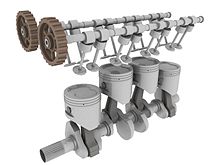3D computer graphics (in contrast to 2D computer graphics) are graphics that use a three-dimensional representation of geometric data (often Cartesian) that is stored in the computer for the purposes of performing calculations and rendering 2D images. Such images may be stored for viewing later or displayed in real-time.
Despite these differences, 3D computer graphics rely on many of the same algorithms as 2D computer vector graphics in the wire-frame model and 2D computer raster graphics in the final rendered display. In computer graphics software, the distinction between 2D and 3D is occasionally blurred; 2D applications may use 3D techniques to achieve effects such as lighting, and 3D may use 2D rendering techniques.
3D computer graphics are often referred to as 3D models. Apart from the rendered graphic, the model is contained within the graphical data file. However, there are differences. A 3D model is the mathematical representation of any three-dimensional object. A model is not technically a graphic until it is displayed. Due to 3D printing, 3D models are not confined to virtual space. A model can be displayed visually as a two-dimensional image through a process called 3D rendering, or used in non-graphical computer simulations and calculations.
Contents[hide]
|
[edit] History
William Fetter was credited with coining the term computer graphics in 1960[1][2] to describe his work at Boeing. One of the first displays of computer animation was Futureworld (1976), which included an animation of a human face and hand — produced by Ed Catmull and Fred Parke at the University of Utah.
[edit] Overview
The process of creating 3D computer graphics can be sequentially divided into three basic phases: 3D modeling which describes the process of forming the shape of an object, layout and animation which describes the motion and placement of objects within a scene, and 3D rendering which produces an image of an object.
[edit] Modeling

The model describes the process of forming the shape of an object. The two most common sources of 3D models are those originated on the computer by an artist or engineer using some kind of 3D modeling tool, and those scanned into a computer from real-world objects. Models can also be produced procedurally or via physical simulation.
[edit] Layout and animation
Before objects are rendered, they must be placed (laid out) within a scene. This is what defines the spatial relationships between objects in a scene including location and size. Animation refers to the temporal description of an object, i.e., how it moves and deforms over time. Popular methods include keyframing, inverse kinematics, and motion capture, though many of these techniques are used in conjunction with each other. As with modeling, physical simulation is another way of specifying motion.
[edit] Rendering

Rendering converts a model into an image either by simulating light transport to get photorealistic images, or by applying some kind of style as in non-photorealistic rendering. The two basic operations in realistic rendering are transport (how much light gets from one place to another) and scattering (how surfaces interact with light). This step is usually performed using 3D computer graphics software or a 3D graphics API. The process of altering the scene into a suitable form for rendering also involves 3D projection which allows a three-dimensional image to be viewed in two dimensions.
[edit] Communities
There are a multitude of websites designed to help educate and support 3D graphic artists. Some are managed by software developers and content providers, but there are standalone sites as well. These communities allow for members to seek advice, post tutorials, provide product reviews or post examples of their own work.
[edit] Distinction from photorealistic 2D graphics
Not all computer graphics that appear 3D are based on a wireframe model. 2D computer graphics with 3D photorealistic effects are often achieved without wireframe modeling and are sometimes indistinguishable in the final form. Some graphic art software includes filters that can be applied to 2D vector graphics or 2D raster graphics on transparent layers. Visual artists may also copy or visualize 3D effects and manually render photorealistic effects without the use of filters. See also still life.[citation needed]

 21.5-inch or 27-inch display with edge-to-edge glass covers nearly the entire front of the enclosure. When all you see is the display, nothing gets between you and what’s onscreen. Movies, TV
21.5-inch or 27-inch display with edge-to-edge glass covers nearly the entire front of the enclosure. When all you see is the display, nothing gets between you and what’s onscreen. Movies, TV 


















 AMD today announced the introduction of the ATI Radeon HD 5450 graphics card, the latest addition to the award-winning line-up of ATI Radeon HD 5000 Series graphics cards.
AMD today announced the introduction of the ATI Radeon HD 5450 graphics card, the latest addition to the award-winning line-up of ATI Radeon HD 5000 Series graphics cards.